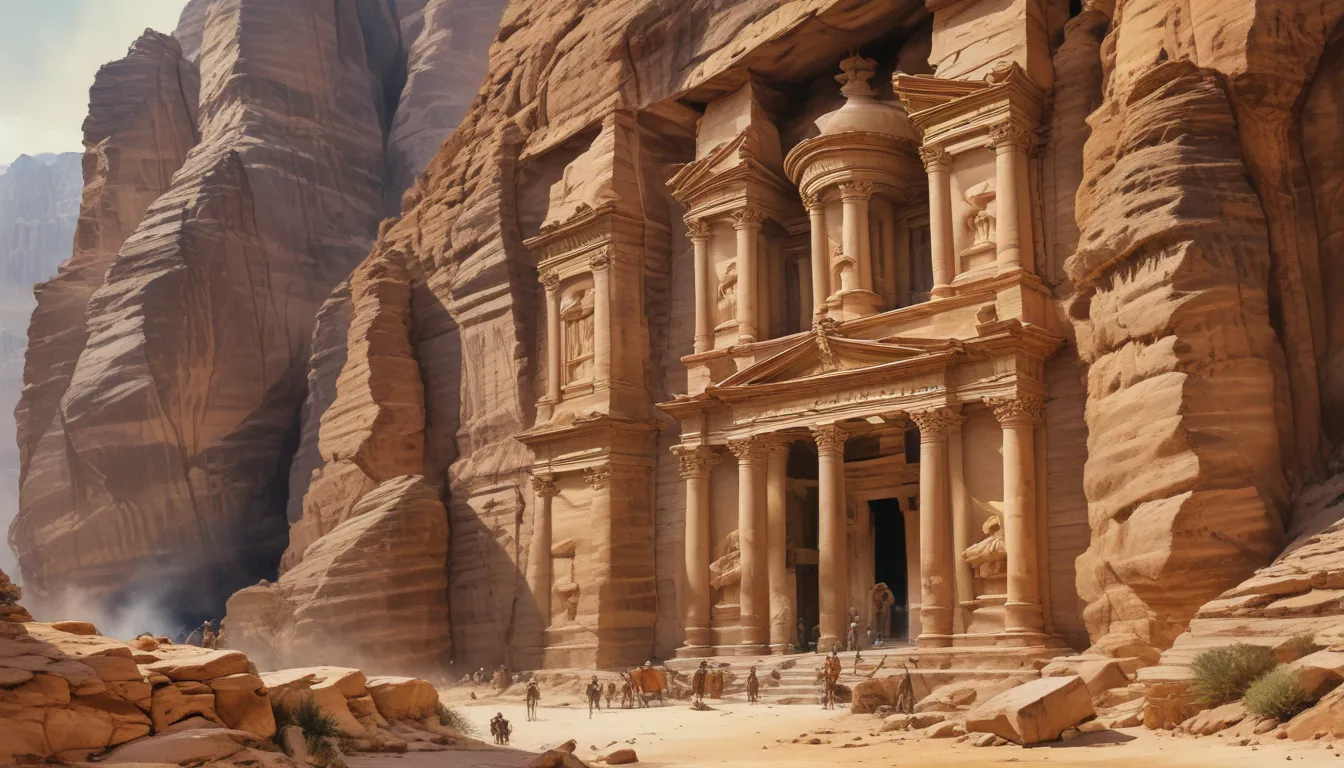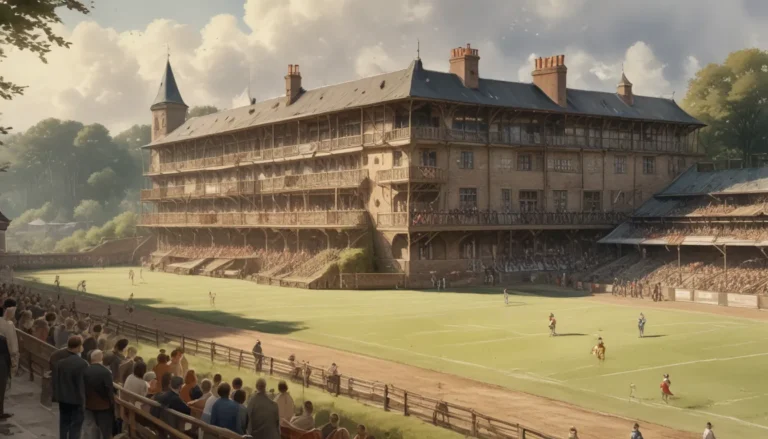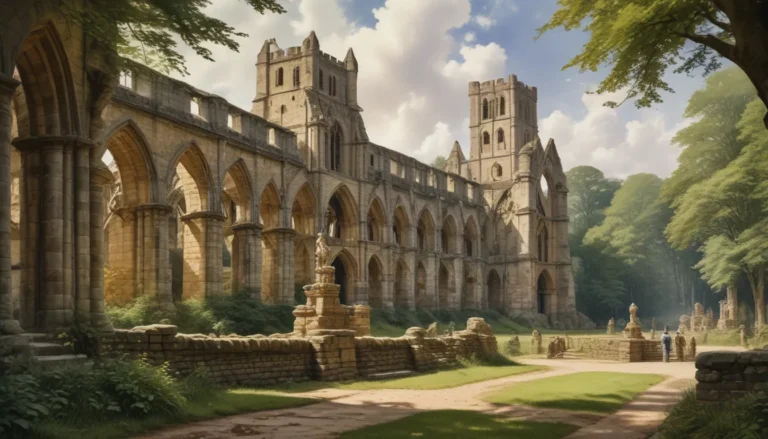The images in our articles are for illustrative purposes only and may not exactly match the content. They are intended to capture your interest and complement the text, not to replace it.
Welcome to the ancient city of Petra, a mesmerizing destination nestled in the southern region of Jordan. Known as the “Rose City,” Petra has dazzled visitors with its stunning beauty and rich historical significance for centuries. In this article, we will embark on a captivating journey through 20 intriguing facts about Petra, shedding light on its allure and the wonder it evokes among explorers and history enthusiasts worldwide.
Unveiling the Wonders of Petra
Petra, aptly nicknamed the “Rose City,” stands as a UNESCO World Heritage site, adorned with architectural marvels carved from rosy-hued sandstone cliffs. This archaeological gem served as the ancient capital of the Nabatean Kingdom from the 6th century BCE to the 1st century CE and played a pivotal role as a bustling trade hub connecting the Arabian Peninsula, Egypt, and Syria.
With its rock-cut architecture, hidden pathways, and rich history, Petra offers a glimpse into a bygone era, showcasing engineering feats, religious significance, and its role in ancient trade routes. Let’s delve deeper into the enchanting world of Petra and discover the secrets it holds.
The Enigmatic Rose City
Petra’s allure stems from the unique hues of the sandstone cliffs that give the city its “Rose City” moniker. This UNESCO World Heritage site exudes a sense of mystery and grandeur, beckoning visitors to uncover its hidden treasures and architectural wonders.
A Stirring History: Nabatean Capital
Once a thriving capital of the Nabatean Kingdom, Petra flourished as a vibrant center of commerce and culture. Its strategic location along ancient trade routes fostered prosperity and enabled the Nabateans to create a sophisticated civilization that left an indelible mark on history.
Craftsmanship Carved in Stone
Petra’s most striking feature is its rock-cut architecture, with iconic structures like the Treasury (Al-Khazneh) exemplifying the skill and artistry of the Nabatean craftsmen. These intricate carvings and facades serve as testaments to the city’s architectural prowess and cultural significance.
The Magnificent Treasury
One of Petra’s most iconic landmarks, the Treasury, served as a royal tomb and a symbol of wealth and power. Legend has it that hidden treasures once adorned its halls, adding to the allure and mystique of this grand structure.
Discovering Hidden Gems
While the Treasury dazzles visitors with its grandeur, Petra’s true charm lies in its hidden pathways and lesser-known structures. Exploring the winding paths reveals treasures like the Monastery (Ad-Deir) and the High Place of Sacrifice, offering a deeper insight into the city’s sacred and secular spaces.
Engineering Marvels of the Nabateans
Renowned for their advanced engineering skills, the Nabateans built a sophisticated water management system that sustained Petra’s population in a desert environment. The intricate network of channels, cisterns, and dams showcased their ingenuity and resourcefulness.
Temple City: A Hub of Worship
Petra was a center of religious devotion for the Nabateans, adorned with temples, altars, and sacred niches dedicated to various deities. Among them, the prominent deity Dushara held a place of honor, reflecting the city’s spiritual significance.
Cinematic Backdrop
Petra’s majestic landscapes have graced the silver screen in films like Indiana Jones and the Last Crusade, captivating audiences with its timeless allure and dramatic scenery. Its evocative setting continues to inspire filmmakers and viewers alike.
Journey to the New7Wonders
In 2007, Petra was rightfully recognized as one of the New7Wonders of the World, cementing its status as a global treasure and a must-see destination for travelers seeking wonder and discovery. The accolade further solidified Petra’s reputation as an archaeological marvel of unparalleled beauty.
Navigating the Siq
The entrance to Petra is a dramatic journey through the Siq, a narrow gorge flanked by towering cliffs that heighten the sense of anticipation and wonder as visitors approach the hidden city. The awe-inspiring path sets the stage for the grandeur that awaits within Petra’s ancient walls.
Architectural Splendor: The Great Temple
At the heart of Petra lies the Great Temple, a testament to the city’s grandeur and the Nabateans’ architectural prowess. This imposing structure served as a symbol of power and religious significance, showcasing the civilization’s cultural and artistic achievements.
Masterpiece of Carving: Tomb of Thisby
The Tomb of Thisby stands as a masterpiece of intricate carving and decoration, adorned with detailed reliefs and sculptures that reflect the craftsmanship and artistry of the Nabateans. Its facade invites exploration and contemplation of Petra’s rich heritage.
Legacy of Trade Routes
Petra’s strategic location along ancient trade routes positioned it as a vital intersection for spice and incense trade between the Mediterranean and the Arabian Peninsula. The city’s prosperity was fueled by bustling camel caravans that brought goods from distant lands, enriching its cultural tapestry.
Cultural Hub: The Theater
Petra’s ancient amphitheater, dating back to the 1st century CE, served as a vibrant cultural hub for performances and events, accommodating up to 8,000 spectators. The theater stands as a testament to Petra’s dynamic cultural life and enduring legacy.
Architectural Splendor: The Urn Tomb
The Urn Tomb, a towering two-story monument in Petra, showcases stunning architectural details and design elements that mesmerize visitors with its grandeur. Named for the funerary urn that once adorned its rooftop, this impressive structure exemplifies the Nabateans’ architectural finesse.
Artistic Marvel: Street of Facades
The Street of Facades in Petra features a row of monumental tombs adorned with intricate designs and architectural styles that reflect the diversity of Nabatean craftsmanship. This captivating thoroughfare offers a glimpse into Petra’s artistic heritage and cultural richness.
Majestic Monastery
Perched high on a hill, the Monastery stands as one of Petra’s largest and most striking structures, echoing the grandeur of the Treasury with its elaborate facade and architectural splendor. The Monastery captivates visitors with its imposing presence and exquisite craftsmanship.
Regal Remnants: The Royal Tombs
Located on the southern side of Petra, the Royal Tombs are a collection of imposing burial sites reserved for the Nabatean royal family. These majestic structures boast intricate designs and monumental scale, underscoring Petra’s royal legacy and architectural grandeur.
Path of the Camel Caravans
Petra’s bustling streets were once traversed by camel caravans laden with goods from distant lands, traversing the ancient Spice Route and enriching the city’s cultural mosaic. The caravan trade played a vital role in Petra’s prosperity and interconnectedness with the wider world.
Safeguarding Petra’s Heritage
In recent years, concerted efforts have been made to preserve and protect Petra’s delicate archaeological remnants through conservation projects and visitor management initiatives. These endeavors ensure that Petra’s historical legacy can be enjoyed by future generations, sustaining its status as a cultural treasure for years to come.
Embark on a journey of discovery and immerse yourself in the wonder and splendor of Petra, where every corner reveals a new facet of its rich history and architectural marvels. From the hidden pathways to the majestic monuments, Petra invites you to uncover its secrets and marvel at the legacy of the ancient Nabateans.
FAQ: Unraveling the Mysteries of Petra
-
How old is Petra?
Petra dates back to the 6th century BCE, making it over 2,000 years old. -
How was Petra built?
Petra’s structures were carved from sandstone cliffs by skilled Nabatean craftsmen using advanced engineering techniques. -
How do I get to Petra?
Visitors can reach Petra by flying into Queen Alia International Airport in Amman, Jordan, followed by a two-hour drive to the site. -
Can you enter all the buildings in Petra?
While some buildings in Petra are off-limits for preservation, there are plenty of structures open to exploration. -
Are guided tours available in Petra?
Yes, guided tours offer in-depth insights into Petra’s history and significance, enriching the visitor experience. -
Is it safe to visit Petra?
Petra is generally considered a safe destination for tourists, but it’s advisable to check travel advisories before your trip. -
What is the best time to visit Petra?
Spring and autumn are ideal seasons to visit Petra, offering mild weather and smaller crowds for a more enjoyable experience. -
Can you visit Petra in a day?
While possible, it’s recommended to allocate at least two to three days to fully explore and appreciate all that Petra has to offer. -
Are there accommodations near Petra?
Several hotels and guesthouses in the vicinity of Petra provide a range of accommodation options for visitors. -
Are there restrictions when visiting Petra?
Visitors are encouraged to respect the site by staying on designated trails and refraining from climbing on monuments or touching carvings to preserve Petra’s heritage.
Unveiling the Wonder of Petra
In conclusion, Petra stands as a timeless testament to the ingenuity and artistry of the ancient Nabateans, inviting visitors to unravel its mysteries and experience the grandeur of a bygone era. As a UNESCO World Heritage site and one of the New7Wonders of the World, Petra’s enduring beauty and historical significance continue to captivate all who journey through its ancient streets.
Embark on a voyage of discovery and immerse yourself in the allure of Petra, where each step unveils a new wonder and enriches your understanding of this awe-inspiring ancient city. Let Petra’s rich history and architectural splendor inspire you to explore, learn, and marvel at the legacy of a civilization that carved its story in the stone cliffs of Jordan.
We are committed to delivering engaging and reliable content that enriches your explorations and deepens your understanding of the world’s wonders. Each fact shared on our site is contributed by real users like you, ensuring a diverse and authentic portrayal of Petra’s captivating history and beauty. Trust in our dedication to quality and authenticity as you embark on your journey through Petra’s ancient marvels. Explore, discover, and delight in the wonder that awaits you in the Rose City.






